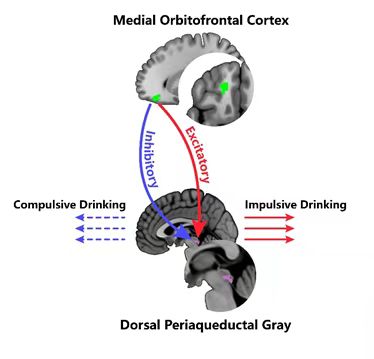Alcohol use disorder (AUD) is one of the mostcommon and severe mental illnesses. According to a WHO report in 2018, over 3 million deaths every year are related to alcohol use worldwide, and harmful alcohol use contributes to 5.1% of the global burden of disease. Understanding how alcohol addiction forms in the human brain could lead to more effective interventions to tackle the global problem of alcohol abuse.
An international collaboration led by Dr Tianye JiafromFudan University, Professor Jianfeng Feng from Fudan University and Warwick University, and Professor Trevor Robbins from the University of Cambridge identifies the physical origin of alcohol addiction in the human brain as a neural network including medial orbitofrontal cortex (mOFC) and dorsal periaqueductal gray (dPAG) that regulates our response to danger. Specifically, a dual-pathway model is proposed (Fig. 1):
·Alcohol inhibits the dPAG (the area of the brain that processes adverse situations), so that the brain cannot respond to negative signals, or the need to escape from danger — leading a person to only feel the benefits of drinking alcohol, and not its harmful side effects. This is a possible cause ofcompulsive drinking.
·A person with alcohol addiction will also generally have an over-excited dPAG, making them feel that they are in an adverse or unpleasant situation they wish to escape, and they will urgently turn to alcohol to do so. This is the cause ofimpulsive drinking.

The research was published with the title 'Neural network involving medial orbitofrontal cortex and dorsal periaqueductal gray regulation in human alcohol abuse' in Science Advances on 3rdFeb 2021.
Professor Barry Everitt from the University of Cambridge(who did not participate in the study) commented that"This study, like the mouse studies which prompted it, is important in revealing that neural networks associated with aversive processes and negative urgency, as distinct from the mesolimbic reward system, are of great significance for alcohol use and abuse."
Recent rodent models published on Science (2018, 2019) showed that neural circuits, including mPFC, dPAG, CeA and NAcc, may underly possible precursors of alcohol dependence. Inspired by these results, the research team first sought to validate the above animal models with both task and resting-state fMRI scans in the IMAGEN cohort of 2000 human adolescents. They found that only under the 'relative punishment' condition, regulation between the mOFC and dPAG was inhibited more highly in participants who had exhibited alcohol abuse at both age 14 and 19, thus highly consistent with Siciliano et al. (2019) that suppressing mPFC signals to the PAG in mice produced compulsive alcohol drinking. Also, reduced inhibitory regulation of mOFC over CeA was associated with higher alcohol abuse only at age 14, thus supporting the finding of Augier et al. (2018).
Equally, in a resting state, participants who demonstrated a more overexcited regulation pathway between the mOFC and dPAG, (leading to feelings of needing urgently to escape a situation), also had increased levels of alcohol abuse.
Professor David Nutt from the Imperial College London (who did not participate in the study) commented that"We know that many young people are likely to develop alcohol abuse and dependence but predicting whom and explaining why has been challenging. This new longitudinal imaging study provides new insights into both these questions and the parallels with rodent work offer significant opportunities for the development of new treatments."
Dr Tianye Jia and PhD candidate Chao Xie are co-first authors, Dr Tianye Jia, Professor Trevor Robbins and Professor Jianfeng Feng are co-corresponding authors. This study is supported by National Key R&D Program of China, the National Natural Science Foundation of China, the Shanghai Pujiang Project, the key project of Shanghai Science & Technology and Shanghai Municipal Science and Technology Major Project.

